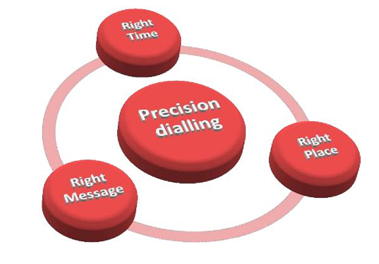The Future of Outbound is Precision Dialling: Rostrvm Solutions
Author: Rostrvm Solutions
Date: 31st May 2013
How to optimise your outbound contact activities
Precision dialling
Precision dialling uses intelligence gained about a contact to optimise dialling activities. It ensures your customer contact achieves the break-through results it needs to be successful.
What’s Precision Dialling all about?
Precision Dialling gives you the optimum chance of making contact with your customers because you dial:
- At the right time
- In the right place
- With the right message and medium to catch their attention
So there’s no more endless re-dials to the same person with the associated risks, wasted time and effort. Rostrvm Solutions can take your contact operations from traditional Preview, Predictive and Progressive dialling to modern Precision Dialling.
To truly optimise your customer contacts make your dialler work for you.
 Stop bad habits and be more PRECISE
Stop bad habits and be more PRECISE
- Define what you mean by a successful outcome to a campaign – are you measuring success by how busy your agents are, or are you focussing on what counts - how successful the outcomes of their calls are?
- Before planning campaigns, define what you consider to be a value call – is it purely having a live connection? Or you might be looking at more discrete call outcomes like 'how many sales have we made?', 'how many add-ons have we added to this policy'? etc.
Now let’s look at why contact centres aren’t achieving optimal outcomes but frequently spend significant amounts of time failing to connect to valuable, live contacts...
Right time – right stats
Precision dialling at the right time means having stats and intelligence – but not relying on just one or the other, or you could get a false picture.
If you’re not measuring it, you won’t know about it
First of all, get meaningful management data so that you can take precise action. For example, if you haven’t got proper statistics which cover calls for each day of your operation, how will you be able to see where peaks and troughs are, so that you can make improvements? How would you know, for instance, that, after a dip, your call rates start to build again at 6pm and so it would be worth, say, staying open for longer, if you have no stats to tell you?
Or perhaps at 4pm in the afternoon you get a sudden peak of inbound calls just when it’s a good time for outbound calls - maybe outbound is starting to add value then but the agents are spending their time dealing with inbound. This information could tell you that you need to change your staff levels - or at least ensure calls from those who called in but weren’t connected are returned as soon as possible.
Build your stats by looking at your operation and what people are doing, so that we get a context for what the business is trying to achieve. Then we take the stats and match what they are saying with what you tell us you’re trying to do and pinpoint discrepancies to help you make improvements.
Even when you have the stats though, your outbound connections might not be live and valuable but connects to answer machines. So you also have to delve deeper to identify the right time to call.
Right time to call

Looking at the operation as a whole, the greatest improvement in outbound performance might be to call at the same time as the inbound peak. But this contravenes normal thinking about blending, where agents are only released to make outbound calls when the inbound rate has dropped off.
There is obviously a good reason why contact centres don’t tend to make inbound and outbound calls at the same time; whilst it would be effective for connections, the glaring problem is it's extremely difficult to employ people to work for, say, two frenetic hours in the morning and four similarly busy hours in the afternoon. If you've got full time staff there, you will probably need to be able to use them all day in a sensible way.
Get the right intelligence
Analysis of millions of calls shows high call connection rate early in the morning, dropping off after lunchtime and picking up again at 4 pm. So, in general, you might expect this to be the template profile for all operations – but specific campaigns have completely different connection profiles. To get precision and the most effective campaign outcomes you need to use more intelligence about each individual you’re trying to contact.
Precision Dialling is predicated on the idea that you have some knowledge about each customer - they may have contacted you through the web; they may have created a quotation on your web site or via an aggregator so you know that they're currently active; or they may be a long-standing, existing customer so you will have some history of when it is they call you. You should be able to look at your inbound records to pinpoint the best time to call that person, based on when they call you.
You need to dig deeply and look closely at findings to get a true understanding of what is really causing the pattern of connections: who your contacts are, how old they are, what sorts of issues they might have...
If you don’t have much history of the contact, if perhaps you're cold calling for example, clichéd thinking can work until you start building your own records. For example:
- call the over 50s in the afternoon
- if you know someone might have school age children, don't bother during school run times
- if it’s a London postcode try calling later in the evening in case they work late
There are all sorts of possibilities to take into account when pinning down the right time to call.
It’s important to gather intelligence from all areas of your contact centre – inbound and outbound calls, emails, tweets and chats - which might give you valuable customer information.
Rostrvm Solutions
Read the full whit epaper below